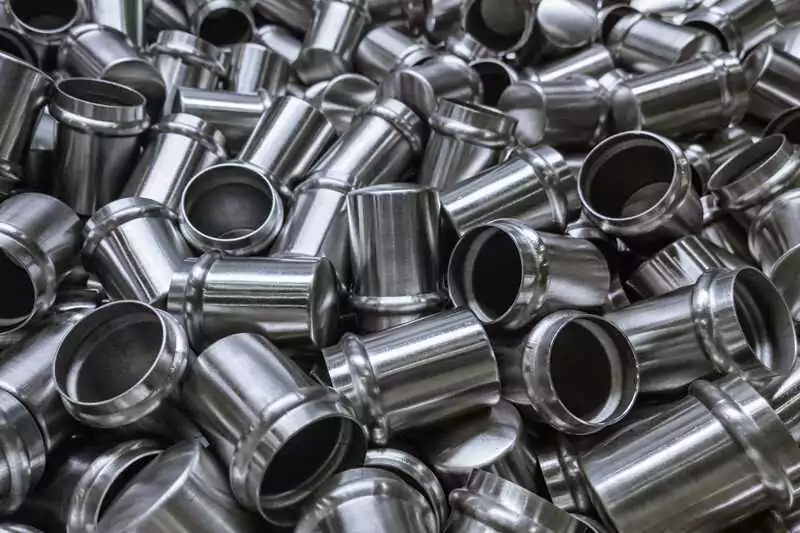Fine Blanking
The fine blanking process is a high-tech stamping technology used to produce stamping parts with smaller dimensions, larger loads, and high precision. It is a precision blanking method developed for general blanking technology.
The fine blanking process includes three forces: blanking force FG, ring gear force FR, and back pressure FS, which makes the fine blanking technology different from other ordinary stamping or blanking processes. The fine-blanking workpiece has many advantages, such as good verticality and a bright-cut surface without tearing.
Because the workpiece is clamped by the blank holder in the die during the fine blanking process, the gap is very small, and the parts are particularly flat. Normally, the cut edges of the parts do not need subsequent processing. The warpage is also small, and the interchangeability is good.
After the combination of upsetting, counterboring, semi-punching, and extrusion, it gradually replaces many complex parts originally made of general punching, forging, machining, casting, and powder metallurgy. After punching, you can assemble multi-functional parts. No need for follow-up processing, and thus, production efficiency and cost advantages are very obvious.
As early as 1923, it was invented and patented by German FritzSchiess. They opened the world’s first fine-blanking factory in Switzerland in 1924. Since then, this technology has been a secret, providing parts for clocks, sewing machines, typewriters, etc. It was not until the 1950s that started growing popular in the public sphere, especially in commercial manufacturing. Before the 1980s, it began to be used in instrumentation, cameras, home appliances, and small hardware. Since then, fine-blanking technology has been widely used in the automobile and motorcycle industries as well as the 3C electronics industry.
Which Parts Are Suitable For Fine Blanking Technology?
Fine blanking use is common for the safety parts in the automotive industry. The parts ensure stable work and error-free operation even under severe and dangerous conditions. The production of automotive fine-blanking parts uses powerful and precision blanking. The geometric shape, dimensional tolerance, form and position tolerance as well as the quality of the cutting surface are much higher than those of ordinary blanking parts.
There are more than 200 common auto parts, including power assembly parts, namely gearbox steel sheet, engine sprocket chain, brake assembly, shock absorption parts, and camshaft. There are also adjustment device parts, namely the seat height adjuster and seat angle adjuster. The seat slide rail parts include safety locks with tighteners and airbags.
Diesel engine injector chucks, poly-v-belt pulleys, valve plates for air-conditioning compressors, torque converter, clutch steel plates and clutch gear hubs, planet carriers, and drive discs in the engine brake discs, parking gears, and pawls, and clutch gear hubs can also use this technology. The technology is also common in the making of brake pads and wheel hub support plates in the chassis.
Parts similar to those mentioned above in the machinery, medical, electronics, hardware, and electrical tools can also use fine blanking.
Spinning-Metal Spinning
Spinning is an advanced technology that combines characteristics of forging, extrusion, stretching, bending, ring rolling, cross rolling, and rolling. It presses against the core mold of the spinning machine, and the spindle drives the mandrel and the blank to rotate. At the same time, the spinning wheel squeezes the material on the rotating core mold from the side of the blank to cause the material to produce continuous plastic deformation point by point, thereby obtaining hollow, rotating body parts with various busbar shapes.
Spinning technology is an ancient technology, similar to turning a pottery wheel to make mud tires. It has two main options: ordinary spinning and powerful spinning. Ordinary spinning does not change the thickness of the blank but only the shape. Power spinning changes the thickness and the shape of the blank.
Modern spinning technology originated in the military industry in the 1950s before it spread to the civilian industry. Spinning can complete various complex sheet metal parts. It is a special forming method that can complete deep drawing, flanging, necking, bulging, and curling.
Compared with stamping, spinning is a low-efficiency processing method, but mold making is simple. Through programming, it can produce small batches of multi-variety, complex shapes, and heavy-load stressed metal parts. The output is huge, with the method of open-die drawing and deep-drawing being the most common for better efficiency.
Which industries and parts are suitable for spinning?
Spinning has a wide range of applications. It is suitable for automobiles, military industry, diving sports, natural gas, lighting, and machinery manufacturing. Spinning is common in the making of home appliances, chemicals, wind power, aerospace, petroleum, natural gas, and rail transit. You can also find it in road construction, advertising, metal processing, musical instruments, and kitchen utensils. Hotel supplies and other industries use this technology.
Spinning can produce the following parts: automobile/motorcycle/truck/bus wheels, spokes, rim lock surfaces, and rail vehicle wheels. Natural gas tanks, CNG tanks, industrial gas bottles, batteries, transportation, and storage tools manufacturing also uses the technology. Fire extinguishers, reflectors, fan parts, cooking pots, separator parts, tank bottoms, heads, fuel containers can also use spinning.
Other parts include drive shafts, cylindrical pipe fittings, precision pipes, hydraulic cylinders, clutch brackets, converter housings, hollow shafts, brake pistons, Multiple V-belt pulleys, flywheel starting gears, drive parts with sealing ring grooves, traffic signal poles, flag poles, precision aluminum alloy poles, crossing poles, hollow shafts with grooves, etc.
Generally speaking, forged wheels for high-end vehicles are light and strong, but the cost is high. Cast wheels for low-end vehicles. In recent years, the quality of the wheels produced by the casting + spinning process improved, and the two have become more and more widely used.


